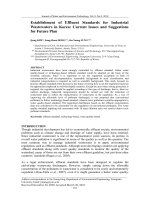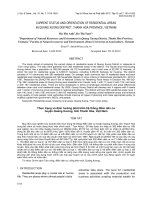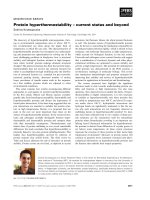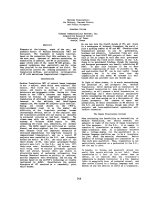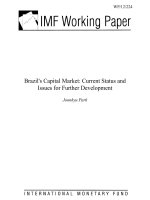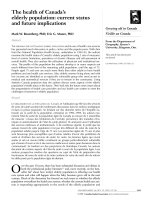Cobia culture in Taiwan: current status and problems pps
Bạn đang xem bản rút gọn của tài liệu. Xem và tải ngay bản đầy đủ của tài liệu tại đây (54.14 KB, 1 trang )
Cobia culture in Taiwan: current status and problems
I Chiu Liao
a,b,
*
, Ting-Shih Huang
c
, Wann-Sheng Tsai
c
,
Cheng-Ming Hsueh
d
, Su-Lean Chang
e
, Eduardo M. Lean
˜
o
a
a
National Taiwan Ocean University, Keelung 202, Taiwan
b
National Pingtung University of Science and Technology, Pingtung 912, Taiwan
c
Penghu Marine Biology Research Center, Fisheries Research Institute, Paisha, Penghu 884, Taiwan
d
No. 32, Nei-an Village, Siyu Township, Penghu, Taiwan
e
Tungkang Marine Laboratory, Fisheries Research Institute, Pingtung 928, Taiwan
Received 18 November 2003; received in revised form 27 February 2004; accepted 2 March 2004
Abstract
Cobia, Rachycentron canadum, is a widely distributed species from the Indo-Pacific waters to the
southern Atlantic Ocean. In Taiwan, it is an indigenous and an ideal species for cage culture. Due to
its high market value in both domestic and international markets, the technology for its culture has
rapidly developed in the past few years. These include mass propagation through natural spawning of
captive broodstocks, larval rearing techniques, nursery production in tanks, ponds and nearshore
cages, and grow-out culture in offshore cages. Reproduction in captivity is relatively easy because
sexual maturity often occurs within 2 years of culture. Spontaneous spawning occurs year around at
water temperatures of 23 –27 jC, with peak during spring and autumn. Fertilized eggs hatch within
21–37 h at water temperature of 31–22 jC. Larval growth is fast, and larvae are vitally robust and
environment tolerant compared to other marine fishes. Fry can be mass-produced in outdoor ponds at
relatively low cost. Weaning of fry from 20 days old onwards to pellet feeds is feasible. Nursery
rearing from 10 –30 to 1000 g can be done in either outdoor ponds or nearshore cages. Major
diseases affecting cobia include bacterial (pasteurellosis, vibriosis and streptococcosis), parasitic
(myxosporidea, Trichodina, Neobenedenia and Amyloodinium infestations), and viral (lymphocystis)
ones.
In recent years, intensive and super-intensive recirculation systems for nursery (from 2 to 100 –
150 g) were developed with survival rates of more than 90%. In nursery and grow-out offshore
cages, 100 –600 g cobia were cultured within 1–1.5 years when they reached 6 –8 kg for export to
Japan, or 8–10 kg for the domestic market. Currently, around 80% of marine cages in Taiwan are
devoted to cobia culture. However, some problems still exist in cobia culture that needs to be
addressed and solved to increase production. These include high mortality due to stress during
0044-8486/$ - see front matter D 2004 Elsevier B.V. All rights reserved.
doi:10.1016/j.aquaculture.2004.03.007
* Corresponding author. Department of Aquaculture, National Taiwan Ocean University, 2 Pei-Ning Road,
Keelung 202, Taiwan. Tel.: +886-2-24623055; fax: +886-2-24634994.
E-mail address: (I C. Liao).
www.elsevier.com/locate/aqua-online
Aquaculture 237 (2004) 155–165
